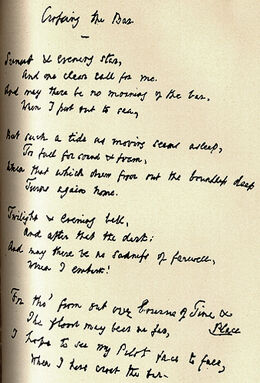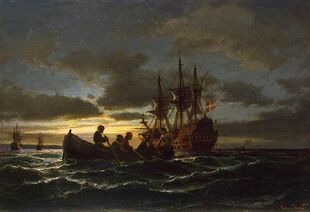
ms. copy courtesy University of Souch Carolina.
"Crossing the Bar" is an 1889 poem by Alfred, Lord Tennyson that is traditionally the last poem in collections of his work. It is thought that Tennyson wrote it as his own elegy, as the poem has a tone of finality about it.
Crossing the Bar[]

"Sea at Night." Painting by Anton Melbye (1818-1875), 1865. Courtesy Wikimedia Commons.

Alfred, Lord Tennyson Crossing the Bar
Sunset and evening star,
And one clear call for me!
And may there be no moaning of the bar,
When I put out to sea,
But such a tide as moving seems asleep,
Too full for sound and foam,
When that which drew from out the boundless deep
Turns again home.
Twilight and evening bell,
And after that the dark!
And may there be no sadness of farewell,
When I embark;
For tho' from out our bourne of Time and Place
The flood may bear me far,
I hope to see my Pilot face to face
When I have crost the bar.
Background[]
Tennyson wrote the poem after a serious illness while at sea, crossing the Solent from Aldworth to Farringford on the Isle of Wight. It has also been suggested he wrote it while on a yacht anchored in Salcombe. The words, he said, "came in a moment"[1] Shortly before he died, Tennyson told his son Hallam to "put 'Crossing the Bar' at the end of all editions of my poems".[1]
Theme[]
The narrator uses an extended metaphor to compare death to crossing the "sandbar" between the tide or river of life, with its outgoing "flood," and the ocean that lies beyond death, the "boundless deep," to which we return. "Crossing the bar" represents traveling serenely and securely from life through death. The Pilot is a metaphor for God, whom the speaker hopes to meet face to face. Tennyson explained, "The Pilot has been on board all the while, but in the dark I have not seen him…[He is] that Divine and Unseen Who is always guiding us."[1]
Form[]
The poem contains four stanzas that generally alternate between long and short lines. Tennyson employs a traditional ABAB rhyme scheme. Scholars have noted that the form of the poem follows the content: the wavelike quality of the long-then-short lines parallels the narrative thread of the poem.
Recognition[]

Crossing the Bar - Tennyson Memorial choral work by Donald McCullough
A choral version of the poem was premiered by the American composer Charles Ives in prototype form on 24 May 1890 at the Baptist Church in Danbury, Connecticut, and published in its current form (arranged for accompanied chorus) in 1894. The poem was also set to music by the English composer Sir Hubert Parry in 1903.
More recent choral settings include those by M. Flora Todd (1949), the Australian composer Graeme Morton (1998), Donald Campfield (2001), Jeff Warner (2005), Valerie Showers Crescenz (2005), Gwyneth Walker (2005), and David Conte (2010).
See also[]
| |||||||||||||||||
References[]
- ↑ 1.0 1.1 1.2 Hill, Robert W., Jr., ed. (1971). Tennyson's poetry; authoritative texts, juvenilia and early responses, criticism. New York: W. W. Norton & Company. ISBN 0-393-09953-9.
External links[]
- Audio / video
- "Crossing the Bar" sung by the Altar of Praise Chorale.
- About
- Tennyson's Poetry: "Crossing the Bar" at SparkNotes
| This page uses Creative Commons Licensed content from Wikipedia. (view article). (view authors). |